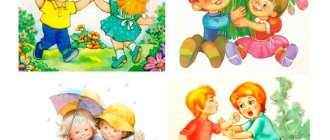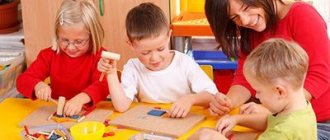Progress of observation
The teacher draws attention to how many birds have flown into the dining room. Offers to look at big birds. What plumage they have, what a big beak, how important and decorous they walk on the ground, slowly, not afraid of anyone. Now look at the magpie. It is much smaller in size than a crow, what a beautiful and unusual plumage it has. The tail is long, and she does not walk on the ground, but jumps from place to place.
Name the similarities and differences in the appearance and behavior of birds.
Outdoor games: “Hide your hands behind your back”
Goal: to develop in children the speed of reaction to a signal. Practice running, catching, and strengthen correct posture.
"Guess what they did"
Goal: to develop children's self-control, initiative, and imagination.
Labor activity Clearing paths of debris.
Goals: to cultivate a love of work.
Individual work “Run to the flag”
.
Goal: develop running speed.
1. Offer board and printed games: “Numbers”
(puzzles)
– develop attention, consolidate knowledge of numbers;
“When does this happen?”
- consolidate children’s knowledge about the seasons and their distinctive features, develop coherent speech and attention;
“In a flower garden, in a vegetable garden, in a garden”
- Goal: to train children in the ability to combine objects according to the place where they grow: where what grows; consolidate children's knowledge about vegetables and fruits and flowers.
2. Individual work – Game “Guess by description”
.
Goals: develop speech; consolidate knowledge about musical instruments.
Tuesday
Morning: Education of KGN: “The neatest ones”
- develop self-care skills, teach how to identify and eliminate deficiencies in clothing and hairstyle;
cultivate neatness. Consideration of the album “My hometown Barnaul”
- Formation of children’s initial idea of the hometown in which they live, call their hometown.
Game "Treasure Chest"
.
Goal: to develop imagination and analysis skills.
Individual. work - Didactic game “When does this happen?”
Goals: to consolidate children’s knowledge of the parts of the day, to develop speech and memory.
Morning exercises No. 14
articulatory gymnastics
GCD
Mathematics No. 1
P/z: show the independence of the counting result from the shape of the arrangement of objects in space. Continue to introduce the cylinder by comparing it with a ball and a cube. Improve ideas about the meaning of words far - close 4
Musical
Walk 1
Magpie watching
Goals:
— expand ideas about spring and the behavior of birds at this time of year;
- enrich knowledge with new words and concepts.
Progress of observation
The sun is warming more and more, the snow is melting, the streams all around are singing their song. Children listen to the murmur of water and say “w-w-w!”
. They float wood chips, branches, and paper boats down the streams.
Many birds have gathered in the bird canteen. List what birds you see? Why do you think they are happy? Pay attention to the magpie, how it also rejoices in spring, cheerfully singing its song. What features have you noticed in the behavior of birds? He will offer to pour food into the feeder, explaining that it is difficult for the birds to get food.
Labor activity
Garbage collection on site.
Goal: to cultivate a desire to work together.
Outdoor games
Individual work Development of movements.
Goal: to consolidate the ability to run quickly at the teacher’s signal in different directions.
Outdoor games: “Mousetrap”
,
"Bubble"
.
Goals: to train the ability to run freely without bumping into each other; act quickly on a signal from the teacher; increase the emotional mood of children.
2nd half of the day: Exercise after sleep No. 14
Walking on massage mats.
— Role-playing game “Library”
— Improve the ability to independently create a game environment for the intended purpose. Encourage children to more widely use knowledge about the life around them in games. Reveal the moral essence of the activities of adults: appropriate attitude to their responsibilities, mutual assistance and the collective nature of work.
2nd walk: Bird watching
Goal: to create a desire to take care of birds;
teach and name birds and body parts; exercise the ability to find differences and similarities in birds.
Progress of observation
The cloud is hiding behind the forest,
The sun looks from the sky -
And so pure, kind, radiant.
If we could get him,
We would kiss him.
What has changed with the arrival of spring? The days began to grow longer, the sun began to appear more often and not only shine, but also warm.
What has changed in the garden? (Thawed patches have appeared.)
Why do you think the snow has not melted everywhere, but lies in small patches? Birds will soon fly in from the south, and if we hang birdhouses on the trees, they will want to live in them.
Every morning they will lift our spirits with their singing and make us happy. They will eat pests on tree trunks and beds. What pest insects do you know? Is an ant a pest? (No, he's a nurse.)
What changes have happened to the trees?
(The buds began to swell.)
Why don’t the buds swell in winter? (A tree, like a bear, sleeps in winter, and when the sun begins to warm up, it wakes up and begins to feed on melt water.)
Outdoor games: “Sparrows and a car”
.
Goals: develop the ability to avoid bumping into each other; listen to the teacher’s command; cultivate friendly relationships.
"Mousetrap"
.
Goals: to practice performing movements; cultivate interest in the game.
Work activity: Sprinkling paths with sand (in the garden)
.
Goal: teach boys to respect girls, do more difficult work (carry sand buckets)
.
Individual work with movement development.
Goal: to strengthen the ability to walk with sweeping steps and jump over obstacles.
Evening: Productive activity. Broken applique “Birds are our friends ”
— continue to develop children’s ability to work in the technique of cutting appliqué, and carefully use paste and brushes.
Individual work with – exercise in sculpting using the “pinching”
.
Wednesday
Morning: - Conversation with children on the topic: “What are nests made of?”
-expand children's knowledge about the life of birds.
-D/i “Recognize the bird from the picture”
— develop children’s ability to solve riddles, correlate a verbal image with an image in a picture.
-Duty in a natural area: watering plants, loosening the soil as necessary.
Individual work with: - Did. game "Flies - does not fly"
Goal: to encourage children to define actions in words, enrich their vocabulary, and consolidate knowledge about birds, insects, and animals.
Morning exercises No. 14
articulatory gymnastics
GCD
TOPIC: " Feathered friends "
P/s: generalize ideas about wintering and migratory birds. To consolidate knowledge about poultry and their young. Reinforce the use of bird names in speech.
Modeling TOPIC: “Birds on our site”
(Golitsyna N. S., p. 189)
P/s: to consolidate ideas about wintering and migratory birds. Strengthen the ability to sculpt using familiar sculpting techniques.
Physical education on street No. 15 (Penzulaeva L.I., p. 82)
P/o: exercise children in walking and running while finding their place in the column, in rolling hoops, in rolling a ball in a forward direction.
Walk 1
Observation of poplar buds Goals: continue to get acquainted with the trees on the site; form the idea that a bud is a house for a leaf.
Progress of observation
The sun is warming more and more, the snow is melting, the streams all around are singing their song. Children listen to the murmur of water and say “w-w-w!”
. They float wood chips, branches, and paper boats down the streams.
Many birds have gathered in the bird canteen. List what birds you see? Why do you think they are happy? Pay attention to the magpie, how it also rejoices in spring, cheerfully singing its song. What features have you noticed in the behavior of birds? He will offer to pour food into the feeder, explaining that it is difficult for the birds to get food.
Labor activity
Garbage collection on site.
Goal: to cultivate a desire to work together.
Outdoor games: “Mousetrap”
Goal: To develop children’s self-control, the ability to coordinate movements with words, and dexterity. Exercise in running and squatting, forming in a circle and walking in a circle.
"Migration of Birds"
Goal: to develop children's self-control and ability to move on cue. Exercise in running, climbing.
Individual work with movement development.
Goal: to consolidate the ability to run quickly at the teacher’s signal in different directions.
2nd half of the day:
Exercise after sleep. No. 14
Walking on massage mats
Labor in nature: Loosening the soil of indoor plants.
Goal: Teach children to care for indoor plants; give children knowledge about why it is necessary to loosen the soil of plants; consolidate loosening techniques and rules for using the necessary items for this. Develop labor skills, accuracy. Foster an ecological culture and respect for the environment.
4. Reading fiction by O. Tsinger “Hello, feathered friends ”
- promote the development of children’s cognitive interest and desire to protect nature.
Walk 2:
Weather observation
Goal: to consolidate knowledge about seasonal changes in nature.



